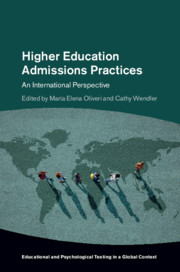Book contents
- Higher Education Admissions Practices
- Educational and Psychological Testing in a Global Context
- Higher Education Admissions Practices
- Copyright page
- Contents
- Figures
- Tables
- Contributors
- Series Editor’s Foreword
- Foreword
- Acknowledgments
- Part I Global Challenges and Common Admissions Models
- Part II Country-Specific Admissions Practices
- Part III Assessments Used in Higher Education Admissions
- Part IV Rethinking Higher Education Admissions
- Chapter 17 The ACT Holistic Framework® of Education and Workplace Success
- Chapter 18 Using Mathematical Models to Improve Access to Postsecondary Education
- Chapter 19 After Admissions: What Comes Next in Higher Education?
- Index
- References
Chapter 18 - Using Mathematical Models to Improve Access to Postsecondary Education
from Part IV - Rethinking Higher Education Admissions
Published online by Cambridge University Press: 09 January 2020
- Higher Education Admissions Practices
- Educational and Psychological Testing in a Global Context
- Higher Education Admissions Practices
- Copyright page
- Contents
- Figures
- Tables
- Contributors
- Series Editor’s Foreword
- Foreword
- Acknowledgments
- Part I Global Challenges and Common Admissions Models
- Part II Country-Specific Admissions Practices
- Part III Assessments Used in Higher Education Admissions
- Part IV Rethinking Higher Education Admissions
- Chapter 17 The ACT Holistic Framework® of Education and Workplace Success
- Chapter 18 Using Mathematical Models to Improve Access to Postsecondary Education
- Chapter 19 After Admissions: What Comes Next in Higher Education?
- Index
- References
Summary
This chapter proposes the use of a mathematical approach that helps support the access and diversity goals of higher education institutions while still maintaining academic standards. This approach, called constrained optimization, allows both academic requirements and other factors – race/ethnicity, income level, social status, geographic region, educational background – to be considered during the admissions process. While diversity efforts vary by country and institution, constrained optimization seeks to improve higher education access for particular groups of students. As such, this may be a useful approach for ensuring that the multiple objectives of the admissions process of any country are achieved.
Keywords
Information
- Type
- Chapter
- Information
- Higher Education Admissions PracticesAn International Perspective, pp. 333 - 346Publisher: Cambridge University PressPrint publication year: 2020
References
Accessibility standard: Unknown
Why this information is here
This section outlines the accessibility features of this content - including support for screen readers, full keyboard navigation and high-contrast display options. This may not be relevant for you.Accessibility Information
- 1
- Cited by
